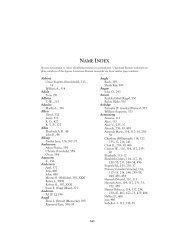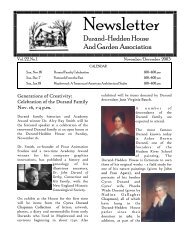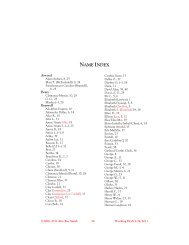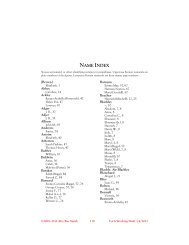Digital Filtering Tutorial, Part II - Alvy Ray Smith Homepage
Digital Filtering Tutorial, Part II - Alvy Ray Smith Homepage
Digital Filtering Tutorial, Part II - Alvy Ray Smith Homepage
Create successful ePaper yourself
Turn your PDF publications into a flip-book with our unique Google optimized e-Paper software.
<strong>Digital</strong> <strong>Filtering</strong> <strong>Tutorial</strong>, <strong>Part</strong> <strong>II</strong><br />
<strong>Alvy</strong> <strong>Ray</strong> <strong>Smith</strong><br />
Computer Graphics Project<br />
Lucasfilm Ltd<br />
Technical Memo No. 44<br />
10 May 1982 (Revised 11 May 1983)<br />
Presented as tutorial notes at the 1983 SIGGRAPH, July 1983, and the 1984 SIGGRAPH, July 1984.<br />
This document was reentered in Microsoft Word on 8 Feb 2000. Spelling and punctuation are<br />
generally preserved, but trivially minor spelling errors are corrected. Otherwise additions or<br />
changes made to the original are noted inside square brackets or in footnotes.<br />
INTRODUCTION<br />
This note is to be considered an extension of <strong>Digital</strong> <strong>Filtering</strong> <strong>Tutorial</strong> for Computer<br />
Graphics [1]. As mentioned in the concluding section, the theory outlined in<br />
that memo does not treat the case of variable rate sampling, as occurs, for example,<br />
in perspective mappings. The Sampling Theorem assumes samples are taken<br />
at a uniform rate. We continue to assume a given input is sampled uniformly—at<br />
the pixels—and that the output is sampled uniformly—also at the pixels. So we<br />
can still use the Sampling Theorem, for example, to reconstruct the original input<br />
from its samples. In case of magnification and minification (scaling the abscissa x<br />
by a constant factor), the spacing of the input samples is changed by the scaling<br />
but the spacing remains uniform. In this memo, however, a less restricted class of<br />
mappings is considered which, in general, does not preserve input sample spac-<br />
ing uniformity. A good illustration of such a mapping is
<strong>Digital</strong> <strong>Filtering</strong> <strong>Tutorial</strong>, <strong>Part</strong> <strong>II</strong> 2
<strong>Digital</strong> <strong>Filtering</strong> <strong>Tutorial</strong>, <strong>Part</strong> <strong>II</strong> 3<br />
the B-spline (beta) cubic spline which are familiar to computer graphicists from<br />
other contexts. The support-8 filters are all obtained from the sinc function from<br />
a window (function). Windowing is accomplished by multiplying a window function<br />
times the sinc function. In all cases the filters are FIR (Finite Impulse Response)<br />
filters [3, 4].<br />
The most simple window is just a box function of unit height and support 8.<br />
This is called the rectangular or Fourier window, and windowing in this case is<br />
simple truncation. The next higher order window is the triangular or Bartlett<br />
window. In the figures are shown several more sophisticated windows named<br />
typically for their discoverers.<br />
Since the ideal filter is the sinc, it must be the case that windowing causes a<br />
non-ideal filter. A feeling for the error introduced by windowing may be got<br />
from considering a step function—ie, a hard edge in a picture. Convolving the<br />
step with a truncated sinc introduces the so-called Gibbs phenomenon, undershoot<br />
before the edge, overshoot after it, and ripples in both places. Furthermore<br />
the edge is no longer straight up and down but is skewed slightly. So the hard<br />
end is softened slightly and appears to “ring” from the ripples on either side. A<br />
successful window function minimizes these annoying artifacts. As can be seen<br />
from Figure WINDOW, the more sophisticated the window, the smaller are the<br />
ripples (the lower is the “peak amplitude of the side lobe”) but the softer is the<br />
edge (“transition width of main lobe”).<br />
Figure WINDOW gives the formulas for Rectangular, Bartlett, Hamming,<br />
Hanning, and Blackman windows. The Kaiser window is a family of windows<br />
where the parameter
<strong>Digital</strong> <strong>Filtering</strong> <strong>Tutorial</strong>, <strong>Part</strong> <strong>II</strong> 4<br />
For many applications, the cubic spline basis functions suffice. It should be<br />
noted that the windowing used above for obtaining support-8 filters could just as<br />
well have been used for arbitrary wide filters, say support-16 filters.<br />
REFERENCES<br />
[1] <strong>Smith</strong>, <strong>Alvy</strong> <strong>Ray</strong>. <strong>Digital</strong> <strong>Filtering</strong> <strong>Tutorial</strong> for Computer Graphics. Tech Memo<br />
No 27, Lucasfilm Ltd, Nov 20, 1981.<br />
[2] Catmull, Edwin, and <strong>Smith</strong>, <strong>Alvy</strong> <strong>Ray</strong>. 3-D Transformations of Images in Scanline<br />
Order. Computer Graphics, Vol 14, No 3, 279-285, Jul, 1980. (SIGGRAPH<br />
80 Conference Proceedings).<br />
[3] Alan V Oppenheim and Ronald W Schafer, <strong>Digital</strong> Signal Processing, Prentice-Hall,<br />
Inc, Englewood Cliffs, NJ, 1975.<br />
[4] Lawrence R Rabiner and Bernard Gold, Theory and Application of <strong>Digital</strong><br />
Signal Processing, Prentice-Hall, Inc, Englewood Cliffs, NJ, 1975.
<strong>Digital</strong> <strong>Filtering</strong> <strong>Tutorial</strong>, <strong>Part</strong> <strong>II</strong> 5<br />
Rectangular: wn ( ) = 1,<br />
0 ≤ n ≤ N −1<br />
Bartlett:<br />
ì 2n<br />
,0£ n£ N - 1<br />
ï N - 1<br />
wn ( ) = í<br />
ï 2n N - 1<br />
2 - , £ n£ N - 1<br />
ïî N - 1 2<br />
wn<br />
1é æ2pnöù = 1 cos<br />
2<br />
ê - ç<br />
è<br />
÷<br />
N - 1øú,<br />
ë û<br />
0 ≤ n ≤ N −1<br />
wn<br />
æ2pnö = 0.54 - 0.46cos ç ÷ ,<br />
èN-1ø 0 ≤ n ≤ N −1<br />
wn<br />
æ2pn ö æ4pn ö<br />
= 0.42 - 0.5cos ç ÷ + 0.08cos ç ÷ , 0 ≤ n ≤ N −1<br />
èN - 1ø èN - 1ø<br />
Hanning: ( )<br />
Hamming: ( )<br />
Blackman: ( )<br />
é 2<br />
2 ù<br />
N 1 N 1<br />
I ê æ - ö é æ - öù<br />
0 wa<br />
ç ÷ - n-<br />
ç ÷<br />
ú<br />
ê è 2 ø ê<br />
2<br />
ú<br />
ë è øû<br />
ú<br />
Kaiser: wn ( ) =<br />
ë û<br />
é æN-1öù I0<br />
êwa è<br />
ç ÷<br />
2 øú<br />
ë û<br />
where I0bg is the modified zeroth order Bessel function of the first kind.<br />
Window Peak Amplitude of<br />
Side Lobe (dB)<br />
Rectangular<br />
Bartlett<br />
Hanning<br />
Hamming<br />
Blackman<br />
-13<br />
-25<br />
-31<br />
-41<br />
-57<br />
Transition Width of<br />
Main Lobe<br />
4 p /N<br />
8 p /N<br />
8 p /N<br />
8 p /N<br />
12 p / N<br />
Figure WINDOW [adapted from [3]]<br />
Minimum Stopband<br />
Attenuation (dB)<br />
-21<br />
-25<br />
-44<br />
-53<br />
-74
<strong>Digital</strong> <strong>Filtering</strong> <strong>Tutorial</strong>, <strong>Part</strong> <strong>II</strong> 6<br />
Figure Captions:<br />
upper left: cubic b-spline basis, -4.0 ≤ x ≤ 4.0, -0.5 ≤ y ≤ 1<br />
upper right: cubic catmull-rom basis, -4.0 ≤ x ≤ 4.0, -0.5 ≤ y ≤ 1<br />
lower left: kaiser window, alpha = 10, -4.0 ≤ x ≤ 4.0, 0 ≤ y ≤ 1<br />
lower right: kaiser window, alpha = 4, -4.0 ≤ x ≤ 4.0, 0 ≤ y ≤ 1
<strong>Digital</strong> <strong>Filtering</strong> <strong>Tutorial</strong>, <strong>Part</strong> <strong>II</strong> 7<br />
Figure Captions:<br />
upper: sinc ∗ rectangle, -4.0 ≤ x ≤ 4.0, -0.5 ≤ y ≤ 1<br />
lower left: sinc ∗ kaiser(4), -4.0 ≤ x ≤ 4.0, -0.5 ≤ y ≤ 1<br />
lower right: sinc ∗ kaiser(10), -4.0 ≤ x ≤ 4.0, -0.5 ≤ y ≤ 1














